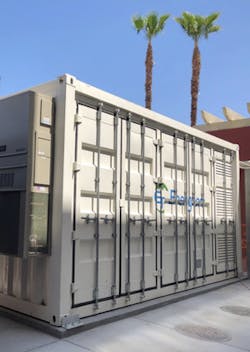Independent Power Producer in PJM Turns to Batteries to Regulate Frequency
A 72 MW/72 MWH battery system owned by a global independent power producer is expected to soon start providing grid services in PJM territory, signaling the storage industry’s increasing maturation and ability to compete with traditional resources.
Industry supporters have argued that getting more storage online to support renewables integration and provide other grid benefits would require compensation schemes that allow storage to compete.
The unnamed power producer, which signed a contract with PJM, will own the battery system. It will be installed in two locations where the company also owns wind power plants, said Ben Williams, director of product and market development for Energport, which provided the battery and associated hardware and software.
He declined to provide specifics of the contract.
The power producer purchased the battery system for the purpose of providing fast responding frequency regulation in PJM territory, he said. It will complement existing wind power generation at the two sites.
Battery system near wind power
The battery system, which may be operating as soon as the end of the year, includes lithium iron phosphate batteries. It was engineered and delivered within four months, a factor that showcases batteries’ ability to quickly meet the needs of the grid.
Energport is also providing inverters that convert DC power to AC, equipment to keep the battery system cool “when everything is running at full tilt,” fire suppression equipment and an energy management system that dispatches the batteries, said Williams.
“We can dispatch up to seven cycles of the system per day.” he said. The system will automatically respond to signals from PJM, he added.
The battery system, divided into 2MW/2MWh energy storage containers, is expected to handle 24/7 operation.
This battery system was chosen because of its high system availability and ability to handle multiple daily cycling. In addition, the system earned high PJM Reg D performance scores, said a press release.
PJM resources qualify and receive compensation based on performance. PJM scores resources based on accuracy, delay and precision.
The system will use existing distribution infrastructure located next to the wind plants.
“This is our first foray into meeting the needs of frequency regulation,” said Williams. It’s also the first time the company has worked with an independent power producer.
PJM has a number of markets for ancillary services which help balance transmission as it moves electricity from generating sources to consumers.
New venture into frequency regulation
While Energport hasn’t as of yet provided batteries for frequency regulation, it has completed residential, commercial and industrial projects.
The larger projects have been designed for demand charge management, to help store renewables in order to make the most of time-of-use rates and for self consumption of solar, said Williams. The company’s main market has been in California, especially taking advantage of the Self Generation Incentive Program (SGIP), which provides incentives for existing, new and emerging distributed energy resources.
Rebates are for distributed energy resources on the customer side of the meter, and go to wind turbines, waste heat to power technologies, pressure reduction turbines, internal combustion engines, microturbines, gas turbines, fuel cells and advanced energy storage systems.
“We see adoption throughout the country — major markets are California, Hawaii, Arizona and the East Coast — areas with a good blend of incentive.”
In 2017, California regulators doubled incentives for the program, giving the lion’s share to energy storage funding.
Energport also has provided energy storage systems for solar system owners in California who want to make the most of time-of-use rates, he said. Those rates have changed recently in ways that make storage more attractive for solar producers.
“We see adoption throughout the country — major markets are California, Hawaii, Arizona and the East Coast — areas with a good blend of incentives,” Williams said.
Energy storage for resiliency
Energport is seeing a growing market for residential storage, not necessarily for economic reasons, but because people are seeking resiliency, Williams said.
The residential market is growing in areas where net metering rules are changing or being eliminated. That includes Hawaii, which eliminated net metering. Now, more solar generators want to store solar and use it on site.
“We don’t contract with homeowners, but we establish distribution channels through solar installers and electrical contractors,” Williams said.
Energport was launched in 2016 by major energy storage players who had been watching the market grow, said Williams.
An Energport partner is Guoxuan High-Tech, the world’s sixth largest producer of lithium ion battery cells and packs.
“Energport was founded by a number of industry veterans who had been following storage for the past decade — folks from big battery companies like Samsung,” he said. “They saw a need to start Energport and serve different types of customers with turnkey engineered systems and provide guidance to help them.”
Track the news as battery systems increasingly compete in wholesale markets. Subscribe to the free Microgrid Knowledge newsletter.
About the Author
Lisa Cohn
Contributing Editor
I focus on the West Coast and Midwest. Email me at [email protected]
I’ve been writing about energy for more than 20 years, and my stories have appeared in EnergyBiz, SNL Financial, Mother Earth News, Natural Home Magazine, Horizon Air Magazine, Oregon Business, Open Spaces, the Portland Tribune, The Oregonian, Renewable Energy World, Windpower Monthly and other publications. I’m also a former stringer for the Platts/McGraw-Hill energy publications. I began my career covering energy and environment for The Cape Cod Times, where Elisa Wood also was a reporter. I’ve received numerous writing awards from national, regional and local organizations, including Pacific Northwest Writers Association, Willamette Writers, Associated Oregon Industries, and the Voice of Youth Advocates. I first became interested in energy as a student at Wesleyan University, Middletown, Connecticut, where I helped design and build a solar house.
Twitter: @LisaECohn
Linkedin: LisaEllenCohn
Facebook: Energy Efficiency Markets

